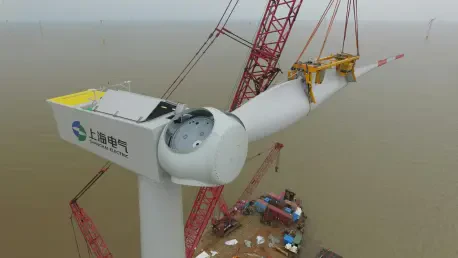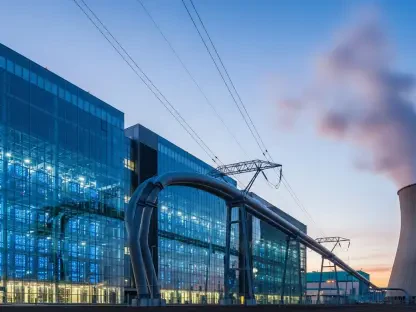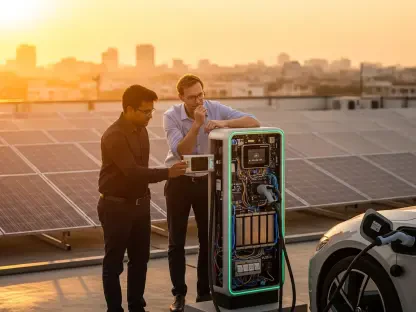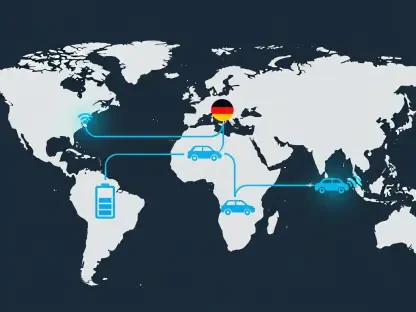Imagine a vast offshore wind farm rising from the ocean, a beacon of renewable energy, yet beneath the waves, the installation process wreaks havoc on marine life with deafening noise that disrupts delicate ecosystems. This hidden challenge of underwater noise pollution has long plagued the offshore wind industry, threatening species like porpoises and clashing with stringent environmental regulations. Amidst this pressing issue, an Amsterdam-based innovator, GBM Works, has emerged with a groundbreaking solution that promises to transform the way wind turbine foundations are installed. With a recent €6.2 million seed funding boost from prominent investors such as Invest-NL and the European Innovation Council Fund, the company is poised to address this critical problem through its pioneering Vibrojet technology. This article delves into how GBM Works is tackling the environmental hurdles of offshore wind installation, the potential of its silent methods to reshape industry standards, and the broader implications for sustainable energy development.
Addressing the Noise Challenge in Offshore Wind
Underwater noise pollution from traditional monopile installation for offshore wind turbines has become a significant barrier to sustainable energy expansion, as the intense sound waves generated during the process can severely impact marine life and disrupt migration patterns. The conventional method, which often involves heavy pile-driving, produces noise levels that exceed safe thresholds for many aquatic species, leading to behavioral changes or even physical harm. Environmental regulations in many regions have tightened in response, creating delays and increasing costs for developers who must comply with strict guidelines. This growing concern has underscored the urgent need for alternative installation techniques that minimize ecological disruption while maintaining efficiency. GBM Works has stepped into this space with a focus on reducing the acoustic footprint of offshore wind projects, offering a promising path forward for an industry under pressure to balance progress with environmental stewardship.
The innovative approach by GBM Works centers on its Vibrojet technology, a system that integrates vibrations with water jets to install monopiles with significantly less noise, achieving reductions of up to 63% compared to traditional methods. Developed as a spin-off from Delft University of Technology in collaboration with industry leaders like DEME Offshore and research bodies like Deltares, this technology represents a fusion of academic rigor and practical application. Beyond protecting marine ecosystems, the method holds the potential to streamline installation timelines and lower costs, addressing both ecological and economic challenges. As global demand for renewable energy surges, such advancements could help offshore wind projects gain wider acceptance by mitigating one of their most criticized impacts. The focus on quieter installation reflects a broader shift toward technologies that prioritize sustainability without compromising on performance.
Funding and Future Expansion of Silent Technology
The €6.2 million in seed funding secured by GBM Works marks a pivotal moment for the company, providing the resources needed to test and scale its Vibrojet system in real-world conditions, with a key demonstration planned at Ecowende by early 2026. This financial backing, supported by a coalition of investors including Rotterdamse Havendraken, signals strong market confidence in the viability of silent installation methods. The funds will be directed toward adapting the technology to diverse soil types, a critical factor for international applicability given the varying geological conditions across offshore sites worldwide. As environmental regulations continue to tighten globally, the ability to offer a versatile, low-impact solution positions GBM Works as a potential frontrunner in this niche but growing market. This investment not only validates the technology’s promise but also highlights the increasing prioritization of sustainable practices in renewable energy development.
Beyond immediate testing, the strategic vision for GBM Works involves expanding its silent installation methods to meet the rising global demand for offshore wind energy, which is seen as a cornerstone of the transition to cleaner power sources. The planned international scaling aligns with industry trends that emphasize both efficiency and adherence to environmental standards, ensuring that projects can proceed without the setbacks often caused by noise-related restrictions. Investor perspectives, such as those from Wouter van Westenbrugge of Invest-NL, underscore the belief that innovations like Vibrojet are essential for the future of offshore wind. This funding milestone provides a foundation for GBM Works to refine its approach and establish partnerships that could amplify its impact. As the technology proves its effectiveness in diverse settings, it could set a new benchmark for how offshore wind farms are built, reducing ecological harm while supporting the urgent shift toward renewable energy on a global scale.
Shaping the Future of Sustainable Energy
The broader implications of GBM Works’ advancements extend far beyond individual projects, pointing to a transformative shift in how the renewable energy sector approaches environmental responsibility during infrastructure development. Offshore wind is widely recognized as a vital component of global energy transition goals, yet its growth has often been hampered by the ecological trade-offs associated with installation noise. By offering a quieter alternative, GBM Works is helping to reconcile the dual imperatives of expanding clean energy capacity and protecting marine biodiversity. This balance is increasingly critical as stakeholders, from policymakers to environmental groups, demand solutions that do not sacrifice one priority for another. The success of such technologies could encourage further innovation in the sector, inspiring other companies to explore sustainable methods that address similar challenges.
Reflecting on the journey so far, the strides made by GBM Works with the support of substantial funding demonstrate a clear path toward minimizing the environmental footprint of offshore wind farms. The collaboration with research institutions and industry partners during the development of Vibrojet technology showcases the power of collective expertise in solving complex problems. Looking ahead, the next steps involve not only proving the technology’s efficacy in varied conditions but also advocating for wider adoption across the industry. Governments and developers could consider incentives for integrating silent installation methods, while continued investment in research might uncover additional ways to enhance sustainability. As the world moves toward a greener future, the efforts of innovators like GBM Works serve as a reminder that technological progress, when paired with ecological mindfulness, holds the key to overcoming longstanding barriers in renewable energy expansion.









